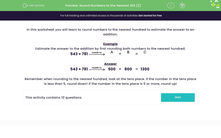In this activity, we will be rounding numbers to the nearest hundred to estimate the answer to an addition.
What does that mean?
Well, it means we need to always be thinking about multiples of 100. So - 100, 200, 300, 400 and so on.
We then need to ask ourselves: 'Which two of these hundreds is my number between?" For example:
230 would be somewhere between 200 and 300.
Once we know which two 100's numbers we are between, rounding means we are picking the one we are closest to. We do this by looking at the Tens number.
If the 10's number is a 0, 1, 2, 3 or 4 we round down to the lower hundreds number.
If it is a 5, 6, 7, 8 or 9 we round up to the higher hundreds number.
You can remember this with a rhyme: "0 to 4 slide to the floor (round down). 5 to 9 climb the vine! (round up)"
So in our example of 230, we know our number is between 200 and 300.
If we look at the Tens number, it's a 3.
That means we round down to the lower hundreds number - 200!
Let's look at some more examples.
Example
Estimate the answer to the addition by first rounding both numbers to the nearest hundred.
|
543 + 781 |
 |
|
+ |
|
= |
|
|
543 + 781 |
|
|
+ |
|
= |
|
Remember when rounding to the nearest hundred, look at the tens place.
If the number in the tens place is less than 5, round down! If the number in the tens place is 5 or more, round up!
Are you ready to get rounding?









